 As they dance in the trees... Jimmy Buffett in "Blue Heaven Rendezvous" WHAT ARE HUMMINGBIRDS? Pollinators, dancing jewels, and zippy little birds HUMMINGBIRD FACTS: The hummingbird gets its name for the distinctive sound it makes while in flight. Hummingbirds have special flight muscles that control wing beats of 38 to 78 times per second. Hummingbirds can hover, fly upside down, and are the only birds that can fly backwards. Hummingbirds range in size of 8 inches, the giant hummingbird which lives at altitudes of 15,000 feet in the Andes Mountains, to the Cuban Bee Hummingbird, which is 2 1/4 inches, the world's smallest. Endemic to Cuba, Mellisuga helenae tips the scales at about two grams, less than the weight of a penny. Hummers have developed a unique adaption to conserve much-needed energy at night when they are unable to feed. They drop their heart rates and body temperatures to conserve energy, a state called "torpor", which is similiar to hibernation. 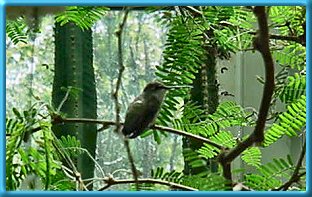 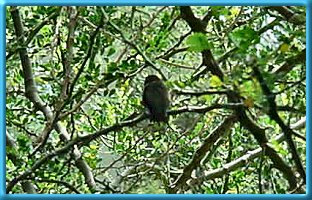 Female Black-chinned Hummingbird Male Black-chinned Hummingbird The Black-chinned hummingbirds were photographed at the North Carolina Zoo in the Sonoran Desert exhibit.
HUMMINGBIRDS IN FLIGHT:
These pictures, though a tad blurry, somewhat show how a hummingbird's wings, tail, and body moves while in flight. They are female and male Ruby-throated Hummingbirds at my feeder at the house. 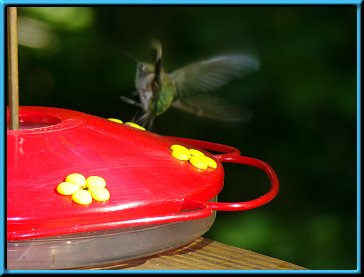
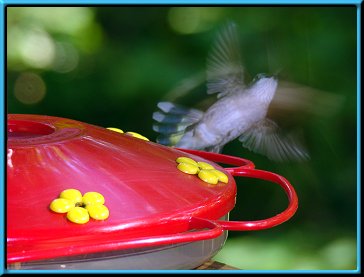 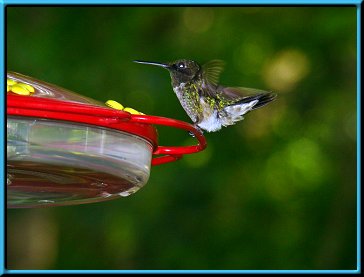
FOOD: Hummingbirds drink nectar at the rate of 13 licks per second. They also have adapted unique lengths and curvatures in their bills to fit the shapes of specific species of flowers that they feed on. Wild hummingbirds get their nutrition by eating many things besides the sugar water solution that people put in their feeders. Their natural diet consists of nectar from flowers, small insects, and spiders (ewwwww!). They pluck them from twigs and leaves and by catching them in the air. They also eat tiny insects they find in flowers while sipping nectar. It is okay to put up feeders with commercially sold solutions or a 1 part suger to 4 parts water boiled solution, but it is NOT okay to feed honey or any artifical sweetener. Honey ferments easily and can cause a fungus that affects hummingbird tongues and can kill them. Sugar water solutions must be changed at least every 48 hours when the temperature is over 60 degrees F due to fermentation too. About adding red dye, it is totally unnessasary, since feeders have red on them and the dye may be harmful to hummingbirds. I never put dye in the solution and they always eat it. When to put up feeders? Depends on where you live. I put them up early in March, because if there is a hummingbird around and it is still cold, he could use the energy due to lack of flowering plants around. And I always see them very early in the year. How long to leave the feeders up? You could leave them up year-round and see what shows up, especially since the Rufous hummingbirds are being spotted in this area well into January. Just take them in at night when it get below freezing or it will freeze and bust. I take them in at night and put them out at first light everyday, due to the raccoons and bears having a "sweet tooth".
NO HUMMERS? There are several reasons you may not get any hummingbirds at your feeders, provided you live where it does get warm for at least part of the year. One is that there may be few flowers, shrubs, or trees in your area that hummingbirds like, and they may not travel to your area and will not "find" your feeder. If there are too many good food sources in the area, they may not bother with feeders. Some hummingbirds may just not want to eat at feeders. Hummingbirds may move away from the feeders to different areas to breed. And, once again, the feeders need to cleaned and fresh solution kept in them to keep hummingbirds. Also, unless you are watching, they may come and go so quickly that you never see them. But keep at it, you may just spot them. You also can attract them by planting trees for shade, perching, and nest building. Plant flowering shrubs and plants to give them natural nectar sources, and this will also attract the insects that they eat too. Having water is valuable too. They get most of their drinking water through nectar, but them bathe too. They especially enjoy a "spray" fountain. BREEDING AND NESTING: THE LOCAL HUMMINGBIRD: The Ruby-throated (Archilocus Colubris) weighs less than 3g (one tenth the weigh of a first class letter). and is no more than 3 3/4 inches long. They are found as far north as Hudson Bay in Canada, and are the predominant species found in western North Carolina (where I live).
Yet all migrate yearly across the Gulf of Mexico into the Yucatan peninsula for the winter. The shortest distance across the Gulf of Mexico is about 500 miles and must be crossed non-stop. The males initiate the up to 1,850-mile move from wintering grounds in South and Central America to breeding habitats in the United States and Canada.
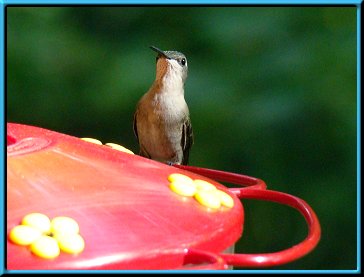
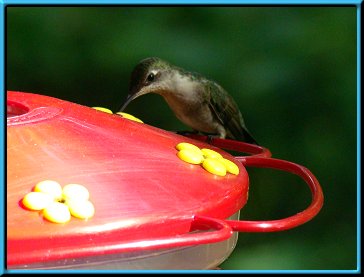 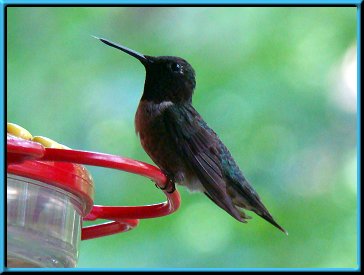 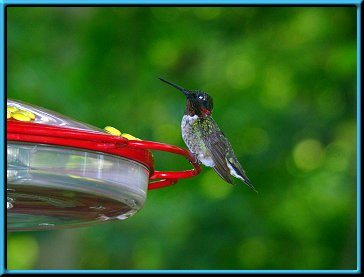 OTHER SPECIES IN THE USA: Found in the eastern USA is mostly the Ruby-throated with the Rufous being spotted more regularly. After storms and hurricanes, especially in southern Florida, you can see non-native species.
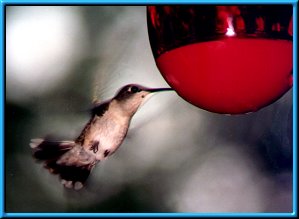
HUMMINGBIRD REHAB: Occasionally, a hummingbird may have an accident and may need to be brought to a rehabilitator. Just like the bird in the following photos. I have had one fly into the house, but it was just stunned. This bird was released after a little care at the WNC Nature Center. It is a female Ruby-throated hummingbird. 


 
"Sleep and Poetry"What is more gentle than a wind in summer? What is more soothing than the pretty hummer That stays one moment in an open flower, And buzzes cheerily from bower to bower? What is more tranquil than a musk-rose blowing In a green island, far from all men's knowing? More healthful than the leafiness of dales? More secret than a nest of nightingales? More serene than Cordelia's countenance? More full of visions than a high romance? What, but thee, Sleep? Soft closer of our eyes! Low murmurer of tender lullabies! Light hoverer around our happy pillows! Wreather of poppy buds, and weeping willows! Silent entangler of a beauty's tresses! Most happy listener! when the morning blesses Thee for enlivening all the cheerful eyes. That glance so brightly at the new sun-rise. ---John Keats (1816)  References and Links
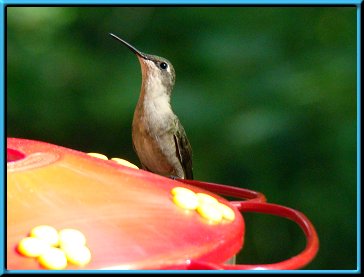

Home Site Map Wildlife of Western North Carolina Email at: dh @ naturehaven.com (take out the spaces and this email address will work) Please Read Guestbook ~~~ Please Sign Guestbook  |
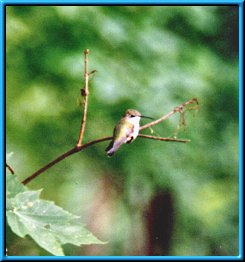 are what they are. There are about 338 known species of hummingbirds. All of them are found in North, Central, and South America. The majority are in South America and are especially numerous in Ecuador and northern Brazil. Sixteen species are known to inhabit the United States, mostly west of the Rockies. The Ruby-throated hummingbird is regularily found to breed east of the Mississippi, but in more recent years the Rufous hummingbird has been showing up regularly in the eastern United States. Hummingbirds are very territorial and will perch in trees and survey the area to attack any who dare to come into their area and try to feed on their food sources! They are great pollinators too. Plants flower and produce nectar to attract hummingbirds, and while the hummingbird sips nectar, pollen is rubbed off onto the bird which in turn visits another flower and pollination has occured! Jewelweed is one plant whose blooming time is closely followed by the Ruby-throated hummingbird, especially the Spotted Touch-Me-Not (Impatiens capensis) species. This plant blooms several weeks later than its cousin, Impatiens pallida, which is pollinated primarily by bees. Ruby-throated hummingbirds rely on spotted touch-me-nots as a source of nectar as they migrate south, and it could be that the later time of blooming has been an adaption of this species to take advantage of hummingbirds as pollinators.
are what they are. There are about 338 known species of hummingbirds. All of them are found in North, Central, and South America. The majority are in South America and are especially numerous in Ecuador and northern Brazil. Sixteen species are known to inhabit the United States, mostly west of the Rockies. The Ruby-throated hummingbird is regularily found to breed east of the Mississippi, but in more recent years the Rufous hummingbird has been showing up regularly in the eastern United States. Hummingbirds are very territorial and will perch in trees and survey the area to attack any who dare to come into their area and try to feed on their food sources! They are great pollinators too. Plants flower and produce nectar to attract hummingbirds, and while the hummingbird sips nectar, pollen is rubbed off onto the bird which in turn visits another flower and pollination has occured! Jewelweed is one plant whose blooming time is closely followed by the Ruby-throated hummingbird, especially the Spotted Touch-Me-Not (Impatiens capensis) species. This plant blooms several weeks later than its cousin, Impatiens pallida, which is pollinated primarily by bees. Ruby-throated hummingbirds rely on spotted touch-me-nots as a source of nectar as they migrate south, and it could be that the later time of blooming has been an adaption of this species to take advantage of hummingbirds as pollinators.
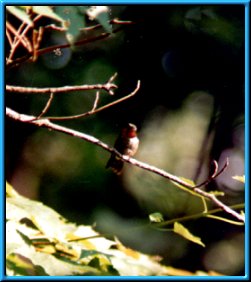 Not a whole lot is known about most species breeding. Most have the male doing a "courtship" dive display to attract a female. She may lead him back to her territory to mate. After mating, the male returns to his territory. So that most hummingbirds that you see spending time together (and not chasing each other away) are feamles and their young or young siblings just becoming independant. All females nest and raise the young on their own. Usually just 2 eggs incubated for 2 to 2 1/2 weeks. She feeds the babies for about 3 weeks. Most hummingbird nests contain downy plant fibers held together with spider silk (eats and nests with spiders, sigh....) coated on the outside with lichens. I could live with less spiders myself, but apparantly hummingbirds "need" them for much, so I guess I will put up the spiders to keep the hummers hummers happy. Often nests are built in the same spot year after year, giving the nest a layered look. They also defecate by hanging their tail ends away from the nest and keeping the inside clean. (Good little housekeeping hummers!)
Not a whole lot is known about most species breeding. Most have the male doing a "courtship" dive display to attract a female. She may lead him back to her territory to mate. After mating, the male returns to his territory. So that most hummingbirds that you see spending time together (and not chasing each other away) are feamles and their young or young siblings just becoming independant. All females nest and raise the young on their own. Usually just 2 eggs incubated for 2 to 2 1/2 weeks. She feeds the babies for about 3 weeks. Most hummingbird nests contain downy plant fibers held together with spider silk (eats and nests with spiders, sigh....) coated on the outside with lichens. I could live with less spiders myself, but apparantly hummingbirds "need" them for much, so I guess I will put up the spiders to keep the hummers hummers happy. Often nests are built in the same spot year after year, giving the nest a layered look. They also defecate by hanging their tail ends away from the nest and keeping the inside clean. (Good little housekeeping hummers!)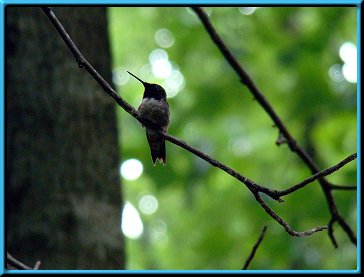 HUMMINGBIRD NEWS: An exotic hummingbird showed up at a woman's feeder in Charlotte, North Carolina in the USA ,about mid November 2000, it was a Green-breasted Mango (Anthracothorax prevostii)! This little guy is about 1,000 miles north of his natural habitat. It was a juvenile and that may have accounted for his rookie mistake in flying way out of his range. This sighting has been confirmed by the
HUMMINGBIRD NEWS: An exotic hummingbird showed up at a woman's feeder in Charlotte, North Carolina in the USA ,about mid November 2000, it was a Green-breasted Mango (Anthracothorax prevostii)! This little guy is about 1,000 miles north of his natural habitat. It was a juvenile and that may have accounted for his rookie mistake in flying way out of his range. This sighting has been confirmed by the